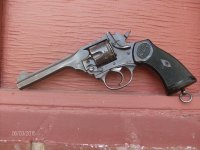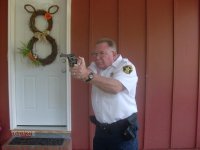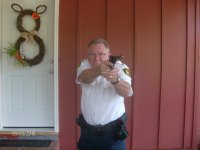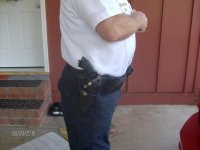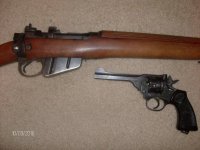Texas, David, M1A, Cyrano, Bryan, and anyone else who may be interested in this project:
Well, I'm still at my cabin, so I don't have all of my tools, but here are the results of the decidedly semi-scientific project that was proposed by Texas. Using a couple (three, but I didn't need that many) of scraps of 2x4, I fired three rounds of .380 2Z ammunition, apparently not British manufacture (marked FN * 380 2Z so maybe Belgian) into the wood. I decided to use the Enfield, as it had the 5" barrel. Here is a picture of the ammunition, posed next to "Churchill's Generals"... (One of the best, in fact).

These bullets penetrated the first 2x4 and lodged almost all the way through the second, and in one case, almost came through the second 2x4, sticking out the farther side, where it could be pulled loose relatively easily. Here is a photo of that test viewed from the face of the 2x4s:

Here is a side view. The bullet would be passing from right to left. You can see how one of the bullets has began to emerge from the second piece of wood, but not enough to completely penetrate both pieces. I believe that the only reason that it got that far is that the previous two shots had loosened some of the far side of the wood, reducing the resistance.

Here is a view of the back of the two pieces of lumber. See how the point of the jacketed bullet is not even scratched or dented in its passage through the wood. (Yes, I know that these are pretty scruffy looking pieces of wood, but the are not rotted or weakened...left over from a project and rescued from the burn pile.):

While I was at it, I thought it might be interesting to fire another three rounds of fresh, modern factory .38 S&W ammunition to compare. I have a new box of Serbian "Prvi Partizan", or as we better know it "PPU" (head stamped with the equivalent Cyrillic letters "ППУ") with a purported 145 gr RNL bullet. Interesting results. These bullets in two instances, did not make it through the first 2x4, and in the third shot, was found to have dented the second piece of wood, but not entered it, and fell to the ground between the two (the dented piece is on the right):

Finally, here are the two spent rounds, along with two unfired rounds for comparison. Note the relatively pristine condition of the spent jacketed round. When I get back to my home shop, I will have a nice specimen to put the micrometer on.
Edit 6:21 PM, May 17, 2016: I was able to put the micrometer to the relatively undamaged jacketed bullet: the groove diameter, even though they are an odd number, because the are so wide in relation to the lands, was easily measured. I took measurements around the diameter of the spent bullet, and they average .357". They run from .356" to .359". This is good for me, as my favorite handloads for the .38 S&W uses the same .358" diameter 158 grain cast and sized lead semi wadcutter bullet that I use for my .38 Special and .357 Magnum handloads, and should perform admirably out of this diameter bore. I also weighed the two recovered rounds, and the jacketed bullet weighs 176.7 grains after being recovered, out of an advertised 178 grain before firing. This could easily have been within the tolerance of manufacture. The recovered RNL weighs 143.7 out of an advertised 145 grains. I forgot to state above that the rounds were fired from 10 feet.
In the meantime, a couple of observations: the military round on an admittedly brief test, penetrated an average of twice as deeply as the RNL commercial round. Neither penetrated very much. Consider that a finished 2x4 is really 1 1/2" thick, then the RNL penetrated about 1 1/2", maybe, and the military round penetrated 3", maybe.

P. S. Cyrano, before I even started this post, I used plenty of really hot soapy water and scrubbed out the barrel, chambers and any areas that might have been exposed to any possible corrosive residue. Then I dried the bore and chambers as best I could, and left the revolver on a radiator for awhile to evaporate any remaining moisture, then ran an oily patch through the bore and chambers and wiped the whole thing down with an oily rag. Takes longer to tell than to do. These rounds, although marked 380 2Z, appear to be of relatively modern manufacture, and may not be corrosive. But considering that even though the outside looks well handled, the bore and chambers of this revolver are bright and shiny, I am not going to take any chances.
Best Regards, Les

